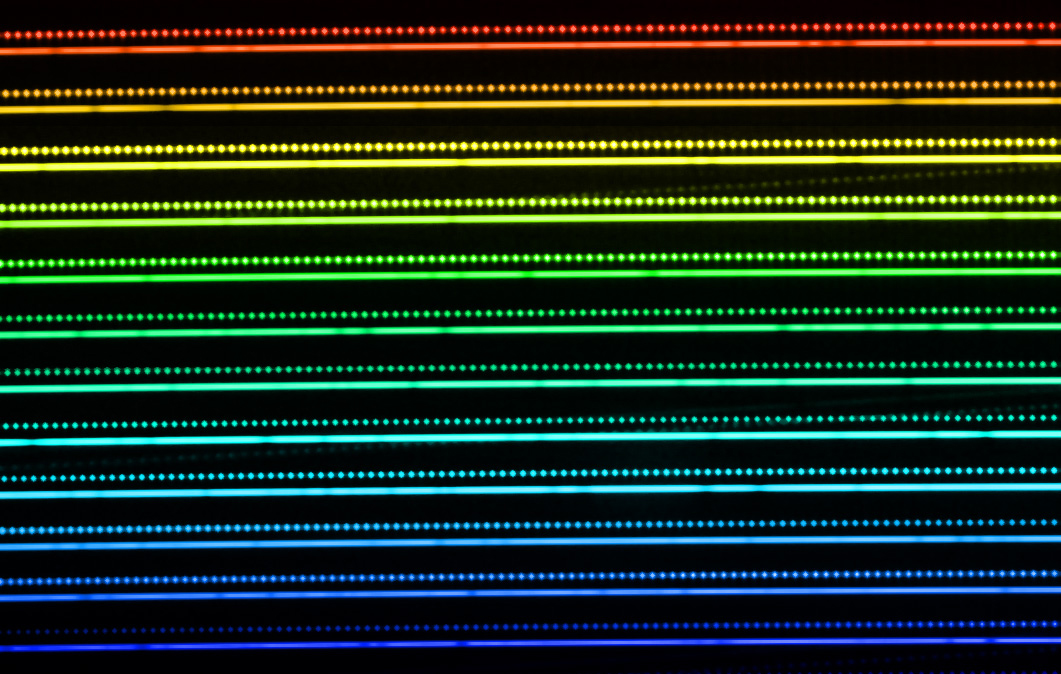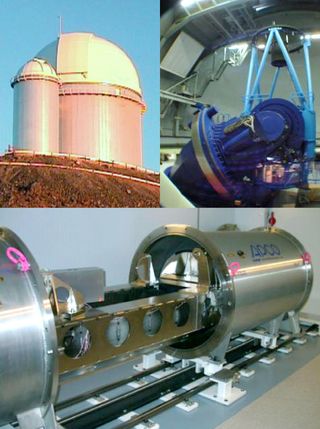'Laser Comb' May Aid Search for Earth-Like Alien Planets

Astronomers searching for alien planets may be a step closer to finding true Earth-like worlds around sun-like stars, by using a new tool that promises to increase the accuracy of planet-hunting instruments tenfold, scientists say.
The laser frequency comb is a calibration tool specifically designed for large ground-based telescopes that search for alien planets through the "wobble method," which identifies extrasolar planets by the gravitational effect (the wobble) they have on their parent stars.
Today instruments such as the European Southern Observatory's High Accuracy Radial Velocity Planet Searcher (HARPS) spectrograph on a telescope in Chile observe planets via the wobble method. But precision is key, and the hollow cathode lamps used to calibrate those spectrometers have their limitations, researchers said — they are not adjustable, can be difficult to gauge, and allow the spectrometers to track the wobble of a star only down to about 30 centimeters per second.
"To detect low-mass planets — down to the Earth mass — in Earth-like orbits requires a precision 10 times better," study co-author Gaspare Lo Curto of the European Southern Observatory told SPACE.com by email. [First Earth-Size Alien Planets Found (Gallery)]
Planet-hunting by star wobble
Lo Curto worked with an international team led by Tobias Wilken of the Max Planck Institute to improve the calibration of large telescopes used in wobble method searches.
So far, telescopes using this method, which measures the Doppler shift of starlight, have lacked the precision to identify rocky alien planets that could boast water as they orbit sun-like stars, considered the most likely to give birth to life.
Get the Space.com Newsletter
Breaking space news, the latest updates on rocket launches, skywatching events and more!
As a planet-hosting star tips toward Earth, its light waves are compressed; as it wobbles away from view, its light waves are spaced out. Measuring the spacing of these wobbles allows astronomers to calculate the mass and distance of the planets causing the shift.
Larger planets closer to their stars produce more significant wobbles. Thus, large, Jupiter-size planets in close orbits were the first bodies found circling other stars.
Over the past 20 years, technological advances led to improved measurements that have turned up smaller and increasingly distant planets. The HARPS spectrograph is one of the most recent additions to the alien planet search.
"HARPS is the most stable astronomical spectrograph, and is supplying the scientific community with the most precise Doppler shift measurements of nearby stars," Lo Curto said. "However, this precision is limited, among other factors, by the precision of the calibration."
Wilken, Lo Curto and their colleagues tried out their new laser comb on HARPS. The results are detailed online in the May 31 edition of the journal Nature.

A laser comb for planet-hunting scopes
As its name suggests, the laser frequency comb emits many lines of light spread apart like the teeth of a comb. Because the distance between the teeth is known, the spectrograph, responsible for reading the light from the star, can use the comb to ascertain that it is correctly reading the stellar signal.
The lines are based on an atomic clock and so are as accurate as that clock, Wilken explained. The comb also can be tailored to fit the exact size of the telescope spectrograph that needs calibration, he said.
The team's laser frequency comb can measure shifts as low as 2.5 centimeters per second, a substantial improvement to the cathode lamp approach — allowing astronomers to see smaller, closer planets, including rocky bodies with the potential of containing water.
Telescopes still would be limited by their aperture, or how much light they can collect. HARPS, even equipped with a laser comb, would capture nothing less massive than Neptune-size planets in the habitable zone around sun-like stars, researchers said.
But larger instruments, such as several giant telescopes currently under development, could fare better. "Future instruments installed at larger telescopes, if equipped with a frequency comb, will have the capability to detect an Earth-mass planet in the habitable zone of a sun-like star," Lo Curto said.
Follow SPACE.com for the latest in space science and exploration news on Twitter @Spacedotcom and on Facebook.
Join our Space Forums to keep talking space on the latest missions, night sky and more! And if you have a news tip, correction or comment, let us know at: community@space.com.

Nola Taylor Tillman is a contributing writer for Space.com. She loves all things space and astronomy-related, and enjoys the opportunity to learn more. She has a Bachelor’s degree in English and Astrophysics from Agnes Scott college and served as an intern at Sky & Telescope magazine. In her free time, she homeschools her four children. Follow her on Twitter at @NolaTRedd